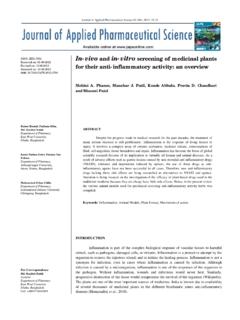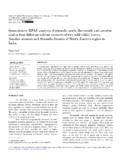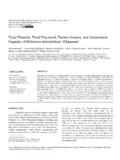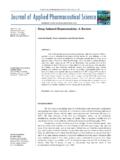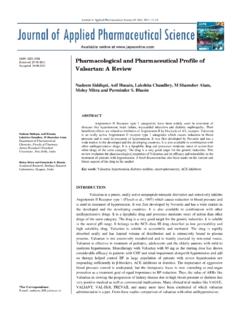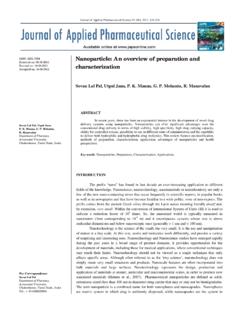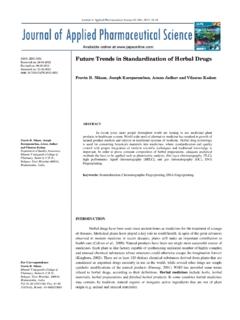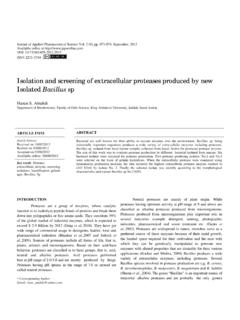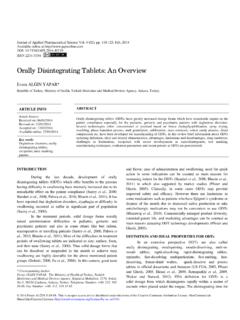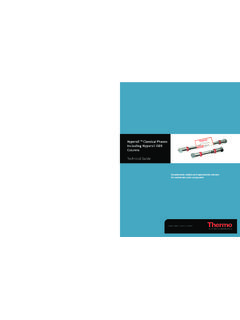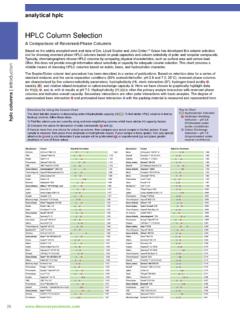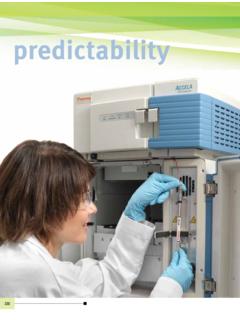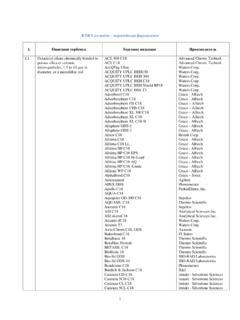Transcription of Development and validation of RP-HPLC method …
1 Journal of Applied Pharmaceutical Science 01 (06); 2011: 165-170 ISSN: 2231-3354 Received: 18-07-2011 Revised on: 22-07-2011 Accepted: 28-07-2011 S. Elumalai University of Madras Chennai, India Kiran Aher, Girija Bhavar Amrutvahini College of Pharmacy, Sangamner, India Sachin Gupta GlaxoSmithKline Pharma Pvt Ltd, Nashik, India For Correspondence: Prof. Aher K. B. Department of Pharmaceutical Sciences Amrutvahini College of Pharmacy, Amrutnagar, Post Sangamner ( ) 422608, Tal Sangamner, Dist Ahmednagar (Maharashtra), India Tel.: +91-02425-259335; Fax: +91-02425-259349 Development and validation of RP-HPLC method for determination of content uniformity of rabeprazole sodium in its tablets dosage form S.
2 Elumalai, Kiran Aher, Girija Bhavar and Sachin Gupta ABSTRACT The aim of the present work was to develop simple, shorter and effective HPLC method with UV detection (285nm) and subsequent validation for the content uniformity determination of Rabeprazole Sodium in marketed tablet samples. The method uses isocratic mobile phase of sodium phosphate buffer (pH adjusted to with sodium hydroxide solution) and acetonitrile 65:35 compositions on reverse phase Lichrosphere RP-100 C8 column. The RSD was observed to percentage and linearity range of (LOQ) 150 percentage of label claim established with correlation, 8 different brands marketed samples were successfully analysed for content uniformity and compared the results with the USP and other guidelines for acceptance criteria.
3 The developed method was found precise, linear, rugged and robust for validated parameters. The method can be used for assay and the content uniformity determination of Rabeprazole Sodium in its tablet dosage form. Key words: Rabeprazole sodium; Content uniformity test; Tablet dosage form; Market sample analysis. INTRODUCTION Content uniformity or the Uniformity of Dosage unit is defined as the degree of uniformity in the amount of active substance among dosage units. The risk assessment strategy underlying content uniformity testing is the assumption that some pre-specified limits exist where safety and efficacy outcomes may change if content uniformity fails (Williams et al.)
4 , 2002) moreover drug content and content uniformity depends on a number of processes associated with its manufacture, hence it is obviously unrealistic to presume every unit to be contained exactly the same amount of the active ingredient as of the label claim, and also due to increased awareness of physiological availability, pharmacopieal standards and specifications have been established to provide limits for allowable variations for the active ingredients in single dosage units (Martins et al., 1998) of all coated and uncoated tablets intended for oral administration where the range of size of the dosage form available include 25 mg or smaller sizes. To study and compare the content uniformity test, a new class of substituted benzimidazole proton pump inhibitor (Dekkers et al.
5 , 1998) Rabeprazole ( )-sodium 2-[[4-(3-methoxypropoxy)-3-methylpyridin e-2-yl] methylsulfinyl] -1 H-benzimidazole (Fig. 1) which covalently binds and inactivates the gastric parietal cell proton pump (H+/K+ ATPase) has been identified. Primary use of Rabeprazole Sodium is to treat heartburn and gastroesophageal reflux disease, ulcers, bacterial Infection due to Helicobacter pylori and Zollinger-Ellison Syndrome, Since Rabeprazole Sodium is unstable in acidic medium it is usually available in enteric coated tablets (Janssen et al., 1999), it offers the same mode of action as that of the other available proton pump inhibitors, but the differing pyridine and benzimidazole substituents result in small, but Journal of Applied Pharmaceutical Science 01 (06); 2011: 165-170 potentially significant different physical and chemical properties, it undergoes activation over a wide pH range when compare to other proton pump inhibitors (Williams et al.
6 , 1999). Several HPLC methods have been published in the literature to quantify Rabeprazole Sodium in plasma samples (Huang et al., 2005) enentiomeric separations (Del Nozal et al., 2004, Toribio et al., 2005, Miura et al., 2006, Rao et al., 2006) identification of degradation products (Dev et al., 2009) and the dissolution test (Cassia et al., 2006), though the drug is not part of any pharmacopoeial compendium and none of the literature method is available for the content uniformity test. The aim of the present work was to develop and validate a simple and rugged content uniformity method for estimation of Rabeprazole Sodium in its tablet dosage form and also to prove its application by comparing it with 8 different marketed samples.
7 Fig. 1: Structure of Rabeprazole Sodium MATERIALS AND METHODS Materials Rabeprazole Sodium enteric coated tablets of Ranbaxy, FDC Limited, Dr Reddys, Zydus Healthcare, Torrent Pharma, Alembic, Intas Pharma and Lupin ltd were purchased from the local market. Rabeprazole Sodium working standard used was purchased from LC-GC Promochem, Banglore. Sodium dihydrogen orthophosphate monohydrate, Sodium Hydroxide, Acetonitrile and Methanol of HPLC grade were purchased from Merck Laboratories, Mumbai. Millipore Membrane filter of m was purchased from modern scientific lab mumbai. MilliQ water was used throughout the analysis and all other reagents used were AR grade.
8 Instrumentation A liquid chromatograph (Agilent 1100 series) equipped with G1322A Degasser, G1311A Quaternary pump, G1313A Automatic Liquid Sampler, G1316A Column Compartment, G1314A Variable Wavelength Detector and Chemstation software was used for the content uniformity and assay test of all samples. Mettler Toledo pH meter (Model Multiseven) was used for pH determination of all solutions. Perkin Elmer UV Spectrophotometer was used for the wavelength selection. HPLC method conditions A Lichrosphere 100 RP C8 column (100 x ,5 ) was eluted with a mobile phase containing Acetonitrile-Sodium Phosphate buffer (pH ; ) (35:65,v/v) at a flow rate of mL min-1 Rabeprazole Sodium was determined by UV detection at 285 nm.
9 The injection volume of 10 l and the run time was 10 min. Preparation of sample solution For content uniformity testing, one tablet or equivalent amount of granule were placed into each of ten 50 mL volumetric flasks. Approximately 30 mL of methanolic sodium hydroxide solution (diluent) was added to each volumetric flask and sonicate until the tablets were dispersed in the solution. The resultant solutions were cooled and volume was made up to the mark with the same diluents. The solutions were shaken well for uniform distribution. Filtered a portion of the solution using m membrane filter and the filtrate was injected for analysis. Preparation of standard solution Approximately 20 mg of Rabeprazole Sodium working standard was accurately weighed into a 50 mL volumetric flask and dissolved in the diluent consisting of methanolic sodium hydroxide solution, mixed well and was injected for analysis.
10 RESULTS AND DISCUSSION method Development and optimization Rabeprazole Sodium is white to slightly yellowish-white solid, very soluble in water and methanol, freely soluble in ethanol, chloroform, ethyl acetate and insoluble in ether and n-hexane. It is more stable in basic conditions, while degrading in acidic conditions. The Chromatographic conditions were optimized for the Rabeprazole Sodium content uniformity and assay method within a short analysis time (10 min) using simple mobile phase and an acceptable peak tailing (< ). In order to achieve these goals, the Chromatographic mobile phase and column were chosen first. The dissociation constant (pKa) of Rabeprazole Sodium is Initially the mobile phase chosen with pH where precipitation observed for standard preparation, hence the mobile phase pH was reduced and optimized as with phosphate buffer.
